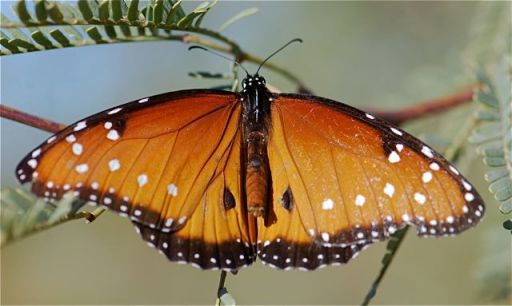Instead of our usual Bug of the Week, today let’s learn a bit about how to identify butterflies.
Quick, do you know what kind of butterfly this is? Does it really matter?
If you want to have an active and successful butterfly garden, then it pays to know your local butterflies. That way you can tailor the plants in your garden to their particular needs.
Butterfly identification may seem intimidating, but there are some tricks to make it manageable. First, arm all your family members with cameras. A photograph can be very handy to help you study the identification details at your leisure. Second, learn the characteristics of the groups of butterflies called families. Once you have mastered those, a trip to the identification guide or website is much more successful. By the way, that butterfly in the photograph is a western pygmy blue, a member of the blue family.
Before we get started, if you are not familiar with what insect parts are called, check out our post with information about caterpillar and butterfly anatomy.
Next, if you are not sure the insect you have is a butterfly or moth, brush up on the differences between butterflies and moths at our website.
Butterfly Identification – Butterfly Families
Entomologists group butterflies with similar characteristics into families. You don’t need to memorize the scientific names (unless you want to do so). I added them so you can add them to your search terms when looking for species.
1. Family Hesperiidae – commonly called skippers
Characteristics: Skippers are butterflies that most resemble moths. Two differences are that they tend to hold their wings at a 45° angle (rather that flat out or folded back) and their slender antennae often end in a hook.
 You can see the angled wings very well in this photograph.
You can see the angled wings very well in this photograph.
2. Family Papilionidae – commonly called swallowtails
Characteristics: Swallowtails are known for their bold, contrasting color patterns and the presence of extensions or “tails” on their hind wings.
 The giant swallowtail has the characteristic look of the family Papilionidae.
The giant swallowtail has the characteristic look of the family Papilionidae.
3. Family Pieridae – called whites, sulphurs, and orange-tips
Characteristics: Most are white, light yellow, or orange, and have simple, rounded wings. They are medium-sized and have normal front legs.
 A sulphur butterfly’s wings are simply elegant.
A sulphur butterfly’s wings are simply elegant.
4. Family Lycaenidae – Coppers, blues and hairstreaks
Characteristics: The members of this family are delicate, very small butterflies. The blues often have blue upper wings, whereas the coppers are brown. Hairstreaks have tiny tails on their hind wings.
 Can you see the tiny tails on the hind wings?
Can you see the tiny tails on the hind wings?
Some people think the tails resemble antennae, thus confusing predators about which end is the head.
5. Family Libytheidae- snout butterflies
Characteristics: Snout butterflies are named for their long, hairy mouthparts that project forward from their head like a snout.
 See how the mouthparts extend way out past the eyes in this snout butterfly? Compare to where the eyes are in the other butterflies in this post.
See how the mouthparts extend way out past the eyes in this snout butterfly? Compare to where the eyes are in the other butterflies in this post.
6. Family Heliconiidae – called the heliconians
Characteristics: Often brightly colored, with wings that are longer than they are wide.
 The wings of this zebra butterfly show the distinctive shape characteristic of the family.
The wings of this zebra butterfly show the distinctive shape characteristic of the family.
7. Family Nymphalidae- the brush-footed butterflies
Characteristics: This family is large and its members vary a lot in color, size and shape. The brush-footed butterflies have reduced (short) forelegs, but it isn’t an easy trait to see.
 The buckeye butterfly in the Butterfly Gardening Week button is a brush-footed butterfly.
The buckeye butterfly in the Butterfly Gardening Week button is a brush-footed butterfly.
8. Family Danaidae – milkweed butterflies
Characteristics: These large brown or orange butterflies are sometimes grouped with the brush-footed butterflies. Their larvae feed on milkweeds.
 Queen and monarch butterflies belong to this family.
Queen and monarch butterflies belong to this family.
1. Butterfly Identification Activity
Now let’s put your new skills to the test.
What families do these butterflies belong to?
1. What family does this black, white and blue butterfly belong to?
2. This brown, orange and white butterfly has one unique characteristic found in no other families. What is it?
3. What family does this butterfly belong?
2. Butterfly Nature Journals and Art Projects
As I’ve mentioned previously, keeping a nature journal or photographic record of your findings is a great idea. Tied with that, drawing or coloring butterfly illustrations helps with recognition and observation skills. Look for free, printable butterfly pages that show realistic butterflies and make some creative art projects. Be sure to take note of the important features of each kind of butterfly.
Butterfly World has downloadable (.pdf or Word) coloring books that feature the exotic butterflies found in their exhibit.
Dover Publishers has a good selection of nature-related coloring books, as well. For example: Butterflies Coloring Book (Dover Nature Coloring Book) by Jan Sovak
______________________________
Disclosure: I am an affiliate for Amazon. If you click through the linked titles or ads and make a purchase, I will receive a small commission at no extra charge to you. Proceeds will be used to maintain this self-hosted blog.
______________________________
Feeling Crafty?
Running with Scissors has an absolutely adorable butterfly metamorphosis smock to make for little ones.
Be sure to keep up with all the posts relating to butterfly gardening with children at our links page.
If you are looking for great children’s books about butterflies and moths, try our list at Science Books for Kids.




















